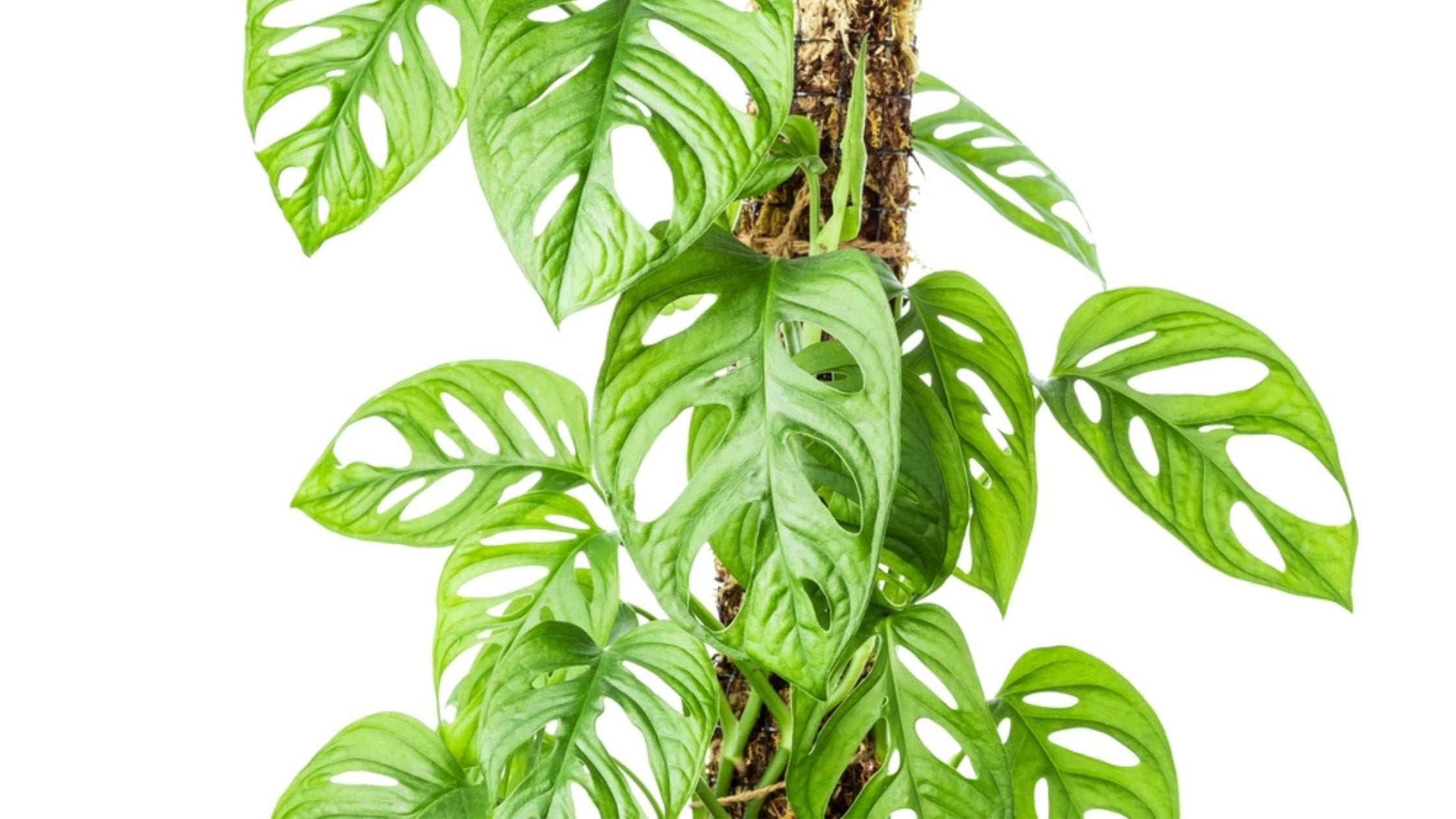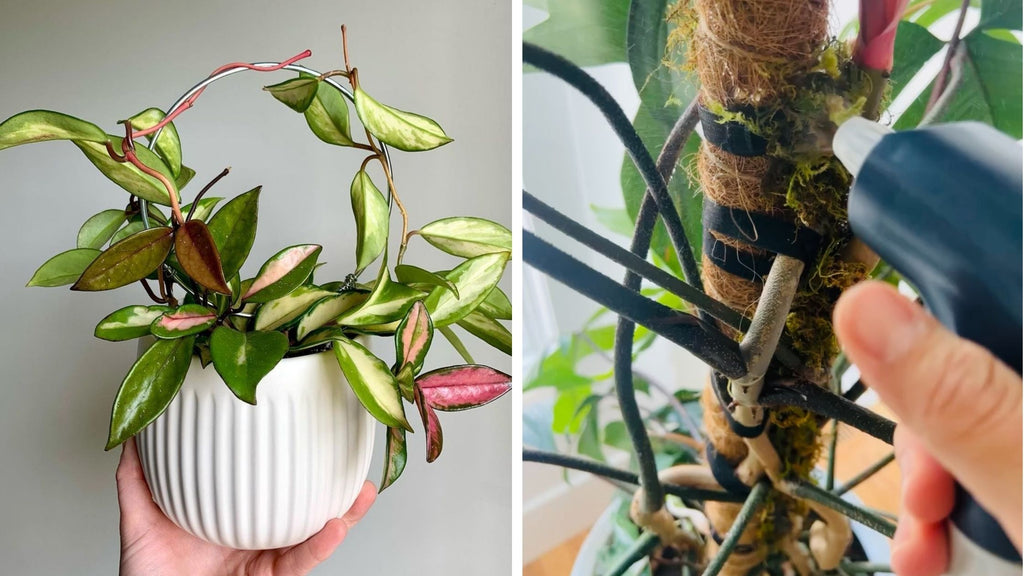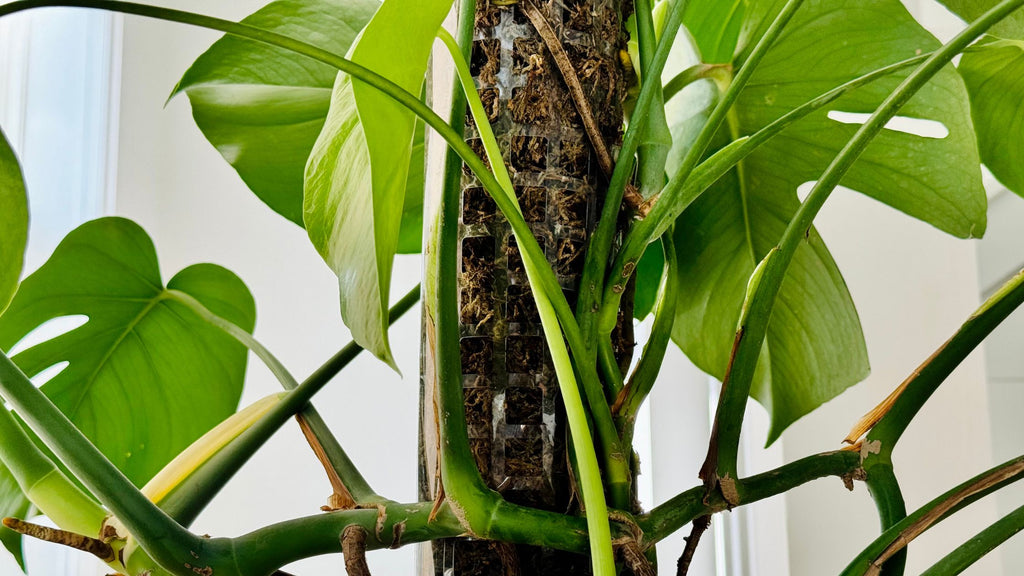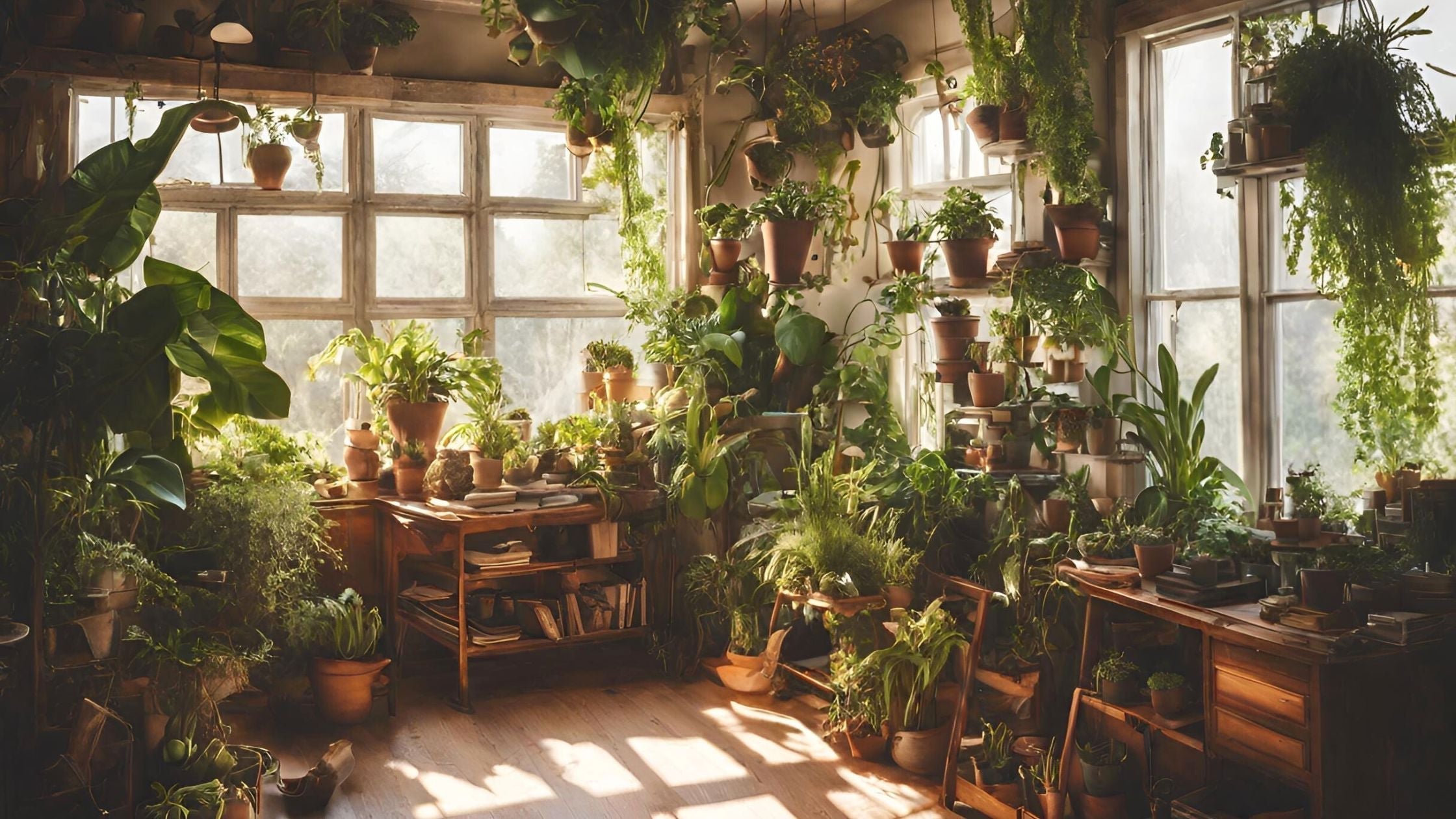
Moss Poles for Plants
Moss poles can help you achieve the indoor jungle of your dreams. They give plants the structure and humidity they need for outrageously fun vertical growth and shockingly larger leaves. You will love watching their aerial roots climb up through the pole, and caring for moss poles is easier than you might imagine.
What is a moss pole?
Moss poles are long hollow tubes with a gridded surface filled with sphagnum moss. They are inserted into plant pots to create a vertical growing habitat for vining plants to root. The pole is watered from the top with a very diluted water and fertilizer solution, creating a damp but aerated, nutrient-rich environment that welcomes hungry aerial roots.
Because of this vertical growing environment, moss poles do not require large pots and can grow infinitely tall in their original pots (just larger in diameter than their pole) by simply adding more moss-filled poles. The extra you spend on poles and sphagnum moss will be more than offset by the savings from larger pots and more soil.
A quick internet search will try to fill your head with other ideas of what qualifies as a moss pole. Let's review a few things that moss poles are NOT.
Moss pole vs trellis - what's the difference?
First of all, I love a good trellis, which supports a trailing vine and allows it to grow in whatever direction you choose. But the difference between a moss pole and a trellis is in the stuffing. A trellis only creates a support system for your plant. It does not provide a rooting medium for aerial roots to find a home and thrive. All of the plant's energy must come from the soil below.
Potted plants with a trellis will need to be repotted into large pots when their root systems outgrow their pot, and their leaves will mostly remain the size of the original plant. Depending on the species and conditions, trellised plants may attach themselves to the pole but won't receive much nutrition unless sprayed with foliar fertilizer. Many trellised plants will need continued help to attach to their pole with clips, wire, or twine.
Coco coir vs sphagnum moss poles
In my humble opinion, coco coir "moss poles" create the most significant misconception about moss poles, and my personal experience of "failing" with coco coir poles backs this claim.
Coco coir is a wonderful product for potting mixes. When added to potting mix, it helps your plants absorb water and nutrients more effectively while reducing oversaturation and preventing waterlogged roots.
If your home has the humidity of a rainforest—with daily intermittent showers—coco coir may work great for your moss poles. However, in the typical home environment, coco coir poles cannot maintain sufficient moisture, even if you regularly spritz and use humidifiers.
My very first "moss pole" was an extendable wooden pole wrapped with coco coir. I paired this pole with an already thriving Philodendron, 'Florida Green,' presoaked the pole, used velcro to strap the vines to the pole, spritzed constantly, and even had a humidifier nearby. I even shoved damp sphagnum moss in some of the spaces between aerial roots and the coco coir. (See the picture above on the right).
Despite these efforts, over the course of many months, exactly zero aerial roots rooted into the pole. Eventually, I decided to repot my Florida Green with a true sphagnum moss pole, and within WEEKS, the eager aerial roots were burrowing into the moss.
The moral of the story: Unless you're growing outdoors in a tropical climate or a botanical garden, coco coir vs sphagnum moss poles is no contest. Only use coco coir as a trellis, not a moss pole.
 What plants like moss poles?
What plants like moss poles?
Any tropical rainforest species with aerial roots - like monstera, philodendron, and pothos - will thrive on a moss pole. Rainforests are competitive habitats with space, light, and resources at a premium. Many of these plants are epiphytic - they have adapted to climb up surrounding vegetation to reach toward the light by growing aerial roots above the soil, seeking new places to grow. Moss poles recreate structures the aerial roots would cling to in the wild, letting your epiphytes vine upward to their heart's content.
How to set up a moss pole
The easiest way to insert a moss pole into a pot is when repotting a plant, but I prefer to start with a freshly rooted cutting or a baby plant from the nursery. For these smaller plants, you can choose a pot just larger than the pole itself.
What you'll need:
- Dehydrated sphagnum moss - I use this one
- One or more moss poles of your choice (We'll discuss the best moss poles and DIY moss poles below)
- One small epiphyte like monstera, philodendron, or pothos (potted or cutting that has grown secondary roots)
- Chunky potting mix like Southside Plants Trail Mix
- 1 500 ml empty water bottle
- A houseplant or hydroponic fertilizer gentle enough to use with every watering
How to set up a moss pole
- Rehydrate the sphagnum moss by submerging it in water until it fully expands. Wring out excess water so the moss is damp but not dripping.
- Follow the instructions on the package for assembling the moss pole.
- Hold the pole vertically with the bottom sitting on the mat or ground while working over a potting mat or outdoors to reduce mess. Drop the moss into the pole by the small handful so it doesn't get stuck. Fill loosely at first, then use a stick or a wooden spoon to pack the moss gently until it is firm. No need to overpack, but this is not an exact science. Leave a few inches at the top so there's room to invert the watering vessel.
- Place the back of the moss pole as close to the edge as possible of the new pot and fill the pot halfway with soil. IMPORTANT: The pole must sit level on the bottom of the pot to ensure the stability of your completed pole.
- Remove the plant from the pot and remove as much of its soil from the roots as possible.
- Place the roots gently around the moss pole, ensuring the plant is snug next to the pole if you have chosen a larger pot. (Did you know monsteras have a front and a back? If that’s what you’re potting, ensure yours faces the correct direction.)
- Fill up the rest of the pot with soil.
- Encourage the plants to grow up the moss pole by fixing them in place with gardening velcro or twine with their nodes closest to the exposed sphagnum moss.
How to water a moss pole
Moss poles retain moisture well, but you must regularly water them. Depending on the humidity in your home and the height of your pole, this is approximately once per week. Fill a 500ml water bottle (1L bottle for larger plants) with water (I prefer conditioning mine with this water conditioner, which removes chloramines and chlorine). Add a few drops of gentle fertilizer and quickly invert the bottle onto the top of the pole. The water will slowly release into the moss. There is no need to water the base pot; check to ensure your tray does not accumulate water.
While it's not necessary, moss pole plants can be sprayed with water or foliar fertilizer like our AirPlant Spray regularly. These humidity-loving tropical plants also love to sit near a humidifier, but typically, the moisture of the pole will be sufficient.
When your plant outgrows your pole
If your moss pole plants grow like mine, you may be surprised by the speed and vigor with which they climb! Adding new segments to extend a moss pole is simple, but at some point, you may want to chop your pole and propagate it.
How to extend a moss pole
Once your plant starts to creep to the top on its moss pole, it's time to extend it. Simply assemble a new section of pole as before, leaving room at the top for the hydrating vessel. The new pole will nest inside the first one with a bit of wiggling and tucking the edges of the plastic inside the top of the other pole.
Continue to encourage your plant's nodes to contact the moss. As the lower aerial roots grow securely into the soil the velcro or twine can be relocated further up the pole.
How to cut a moss pole
At a certain point, your pole will grow to unmanageable heights. One of the coolest things about moss poles is propagating a mature plant like this. Because the plant roots vertically, you can separate at any section of the pole, first chopping the main vine.
Put the "cutting" in a new pot - it will not have any ground roots. Add an extension to your pole, and as long as there are healthy roots, your plant will continue to grow upward with larger and large leaves. You will be expanding your collection in a new and leaf-a-licious way!
The best moss pole for plants
I have been experimenting with moss poles for over a year. I've tried DIY moss poles. I've purchased everything from coco coir poles (imposters!) to every version available online. I even designed a 3D printable pole that I have yet to pull the trigger on. Needless to say, I'm a low-key moss pole expert. Here's what I found:
How to make a moss pole for plants
DIY enthusiasts will promise you that moss poles are easy to make at home, and they're right in theory. The most basic homemade moss pole is made by rolling a sheet of wire mesh into a column and securing it with basic zip ties. You then stuff the pole with moss, set up your pole in the pot with your plant, and you're good to go.
I attempted a DIY moss pole with much less favorable results than I had hoped. For starters, I could not find the type of mesh I wanted even after visiting THREE different major home improvement stores. When I finally sourced the mesh, I managed to scratch and slice open my hands while cutting, rolling, and securing it into a cylinder shape.
Finally—and let's face it, I may just be bad at DIY—the resulting moss pole dried out way too fast because it was exposed to air on all sides.
Ultimately, I found the best moss pole on the market today, which I have used for over a dozen plants. While it's not perfect, this moss pole has a mesh grid on only one side to maintain moisture in the sphagnum moss and make watering less messy. They attach easily, balance well in even the smallest pots, and, most importantly, my plants thrive on them. Stay tuned for Southside Plants moss poles coming soon!
Be sure to check out my monstera moss pole before and after - coming soon. In the meantime, have you tried moss poles? Let's hear about it! Got questions? Leave them below!



Leave a comment
This site is protected by hCaptcha and the hCaptcha Privacy Policy and Terms of Service apply.